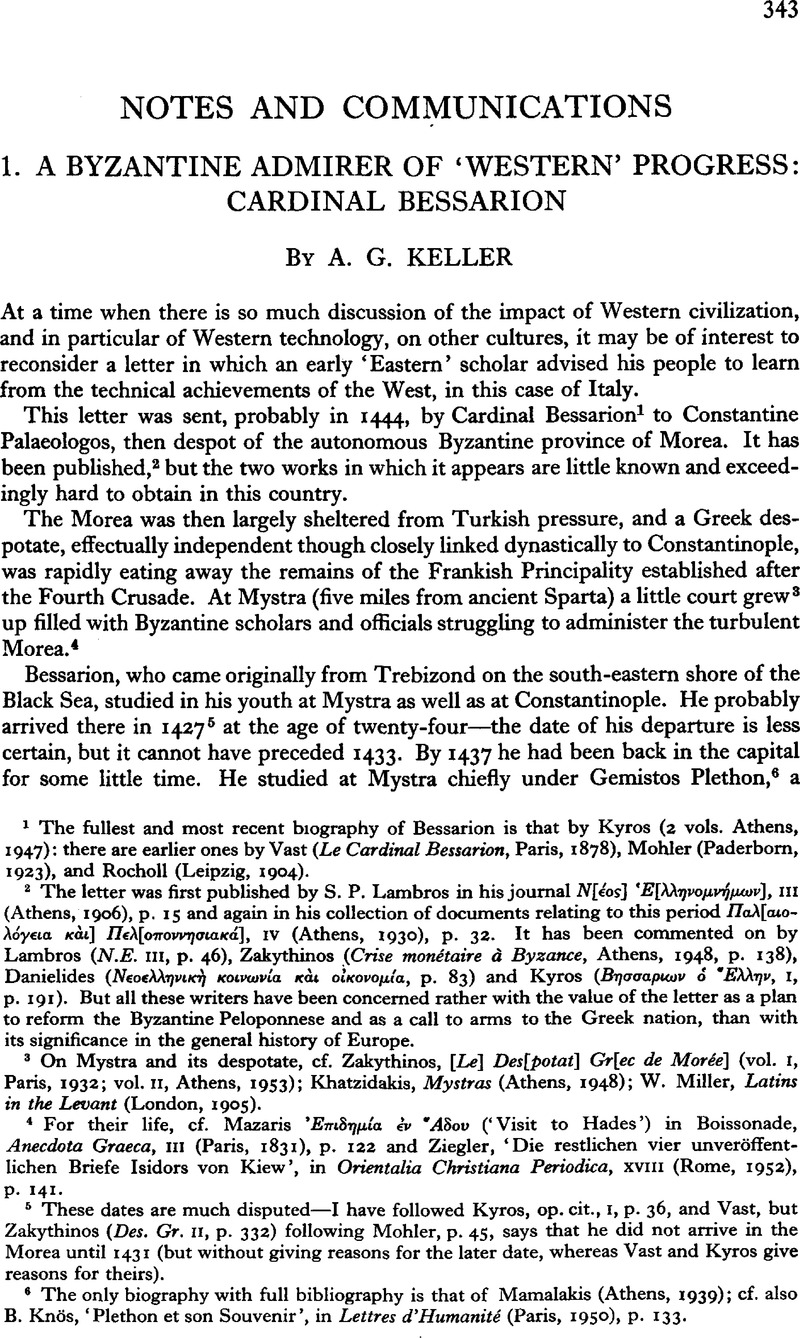Article contents
1. A Byzantine Admirer of ‘Western’ Progress: Cardinal Bessarion
Published online by Cambridge University Press: 20 December 2011
Abstract

- Type
- Notes and Communications
- Information
- Copyright
- Copyright © Cambridge University Press 1955
References
1 The fullest and most recent biography of Bessarion is that by Kyros (2 vols. Athens, 1947): there are earlier ones by Vast (Le Cardinal Bessarion, Paris, 1878), Mohler (Paderborn, 1923), and Rocholl (Leipzig, 1904).
2 The letter was first published by S. P. Lambros in his journal N[ έος’ Ἑ λληνομνήμων], III (Athens, 1906), p. 15 and again in his collection of documents relating to this period παλ[ αιολόϒεια κὰι] πελ[ οποννησιακά],, iv (Athens, 1930), p. 32. It has been commented on by Lambros (N.E. III, p. 46), Zakythinos (Crise monétaire à Byzance, Athens, 1948, p. 138), Danielides (Νεοελληνικὴ κοινωνία κὰι οἰκονομία, p. 83) and Kyros (Вησσαριων ὁ Ἔλλην, I, p. 191). But all these writers have been concerned rather with the value of the letter as a plan to reform the Byzantine Peloponnese and as a call to arms to the Greek nation, than with its significance in the general history of Europe.
3 On Mystra and its despotate, cf. Zakythinos, , [Le] Des[potat] Gr[ec de Morée] (vol. I, Paris, 1932; vol. II, Athens, 1953)Google Scholar; Khatzidakis, Mystras (Athens, 1948); Miller, W., Latins in the Levant (London, 1905)Google Scholar.
4 For their life, cf. Mazaris Ἐπιδημία ἐν Ἂδον (‘Visit to Hades’) in Boissonade, Anecdota Graeca, III (Paris, 1831), p. 122 and Ziegler, , ‘Die restlichen vier unveröffentlichen Briefe Isidors von Kiew’, in Orientalia Christiana Periodica, xviii (Rome, 1952), p. 141Google Scholar.
5 These dates are much disputed—I have followed Kyros, op. cit., 1, p. 36, and Vast, but Zakythinos (Des. Gr. II, p. 332) following Mohler, p. 45, says that he did not arrive in the Morea until 1431 (but without giving reasons for the later date, whereas Vast and Kyros give reasons for theirs).
6 The only biography with full bibliography is that of Mamalakis (Athens, 1939); cf. also Knös, B., ‘Plethon et son Souvenir’, in Lettres d'Humanité (Paris, 1950), p. 133Google Scholar.
7 Cf. elegies on his death by Bessarion and two other pupils, printed as appendices by Alexandre in his edition of Plethon's Traité des Lois (Paris, 1858).
8 Cf. Mazaris, art. cit. (in several places).
9 Cf. Kyros, op. cit. ch. I.
10 Vast, op. cit. pp. 180 ff.
11 Kyros, op. cit. p. 190 and elsewhere.
12 παλ, πελ. p. 44.
13 Constantine arrived in the Morea towards the end of 1443. Bessarion alludes to the Christian alliance in his letter, and it is unlikely that he would have written so optimistically after the disaster of Varna.
14 Published by Lampros, Παλ. Πελ. iv, pp. 23, 29 etc.
15 For the revival of this phrase cf. Plethon, ‘Oration to the Emperor Manuel II’, in Migne, P[atr.] G[raec.] B[ibl.], clx, cols. 821–2.
16 Sathas, Μνημεῖα Ἑλληνικῆς Ἱστορίας iii, (Paris, 1882), p. 380—heavy duties were imposed on ‘omnes sete et grane’, bought at Mystra—but this was also an act of policy to bring the Despot to heel in a more purely political dispute.
17 Lampros has fully discussed this topic in N.E. iii, p. 30.
18 Plethon has interested many historians as a sort of ‘primitive state-socialist’—his two socio-economic tracts are in Migne P.G.B. (see above et seq.). The best account in English is Tozer's, H. S. ‘A Byzantine reformer’, in Journal of Hellenic Studies, vii, pp. 353 ffGoogle Scholar. For a full bibliography cf. Tatakis, M., Philosophie Byzantine (Paris, 1949), pp. 310–11Google Scholar.
19 Παλ. Πελ. iv, p. 42.
20 Ibid. p. 44.
21 For his remarks on the ways in which all Italian states were prepared to change their laws if they felt it necessary, see Παλ. Πελ. iv, pp. 37–8.
22 Bessarion talks of the ‘care of the land, protection of produce, export and disposal of surplus, the maintenance of necessities which are not abundant, importing of what we lack … you will prevent any export of corn … there is no city of Italy so small, no Ruler so weak and poor as not to protect what he needs to, in his own territory … we see how each of them also watches with great care over those professions which do not bear on necessities but only on comfortable living and profit’ (Παλ. Πελ. p. 41).
23 Crombie, , Augustine to Galileo (London, 1932), p. 168Google Scholar; Usher, , A History of Modern Inventions (New York, 1929), p. 144Google Scholar.
24 Crombie, op. cit. pp. 166–7.
25 We may note here the classical definition of mechanics that he uses: ‘engineering and mechanics, by which weights are drawn about, and being lowered, are easily struck and smoothed where necessary’ (Παλ. Πελ. iv, p. 43); cp. Usher, op. cit. p. 70, for a discussion of the Greek and Arabic titles of Hero of Alexandria's book on mechanics—‘the elevator’ and ‘on the raising of heavy weights’. The opening of Hero's Pneumatica closely resembles Bessarion's definition. Bessarion possessed at least two copies of the Pneumatica, one of which (Marc. gr. 1025) clearly impressed him—he notes that it is in a volume: ‘Novus, Pulcher, Continens multa et diversa opera quae novo reperiuntur.’ Also he had a translation of the Machinae Bellicae made by one of his protégés—probably a Morean (Marc. lat. 339).
26 Crombie, op. cit. pp. 188–9.
27 Who was, however, even more concerned with self-sufficiency in textiles (‘Oration to Manuel II’, Migne, P.G.B., clx, col. 838).
28 Παλ. Πελ. iv, p. 43.
29 Which now reached its highest peak of subtlety (Mumford, Technics and Civilisation, pp. 124–9).
30 Crombie, op. cit. p. 195.
31 Sathas, op. cit. p. 380; cf. n. 18 above.
32 Cf. Bessarion's letter to the friar Jacopo Picentino, Παλ. Πελ. iv, p. 255—but in fact information on industry in the fifteenth century is scanty (cf. Des. gr. ii, pp. 247, 251–2, and R. Lopez, ‘Silk industry in the Byzantine empire’, in Speculum, xx, p. 1).
33 This was the ‘Mariegola dell' Arte di Tentori’: Sansone, J. A., Dyeing (Manchester, 1888), p. 3Google Scholar; cf. article on ‘Dyeing’ in Enc[yclopaedia] Brit[annica[, viii (1910), p. 745.
34 Mumford, op. cit.; cf. art. on ‘Glass’ in Enc. Brit, xii (1910), pp. 100–1; E. Péligot, Le Verre, pp. 334–9.
35 A. Diller, ‘A geographical treatise by G. G. Pletho’, in Isis, xxvii, pp. 441–51. Plethon also made numerous extracts from classical scientific writings—e.g. those of Strabo, Aristotle and Theophrastus.
36 Regiomontanus in his introduction to his epitome of Ptolemy's Almagest (Marc. lat. 328) says that Bessarion himself had been planning to compose this epitome in order to extend the knowledge of Greek science in the West, but lack of time forbade. The visit to Germany was in 1460 (Kyros, op. cit. ii, pp. 76–7); cf. also Regiomontanus's letter to Bessarion on the ‘Meteoroscope’ in his edition of the Geografia, 1514.
37 His great work In Calumniatorem Platonis was printed by Sweynheim in 1469 (Vast, op. cit. p. 360).
- 6
- Cited by


